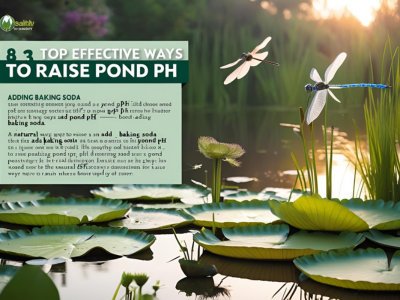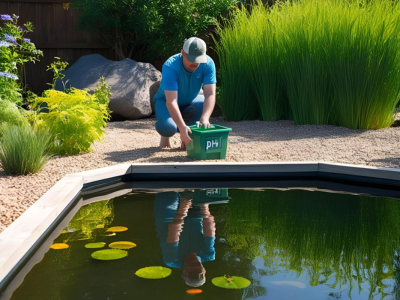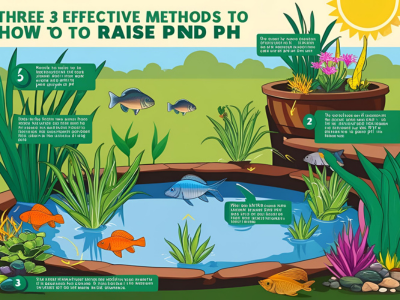Introduction
In this Article You Will Learn How to Raise Pond pH. Ponds are beautiful additions to any garden or backyard, but did you know that keeping your pond’s water in the right condition is very important for your fish? One of the most important things to monitor the pH level of the water.
pH is a measure of how acidic or basic the water is. Fish like a pH between 6.5 and 8.5, with the best being 7.4, which is close to their blood. If the pH goes too low (below 6.5) or too high (above 8.5), your fish can get stressed or sick.
In this guide, we’ll show you how to test and manage the pH levels of your pond water to make sure your fish stay healthy and happy.
What is pH and How Does It Affect Your Fish?
pH is like a scale that tells us if the water is acidic (sour), neutral (balanced), or basic (slightly soapy). If the water is too acidic or too basic, your fish might feel uncomfortable. Fish can get sick if the pH changes too much. The best pH for most pond fish is around 7.4, which is just right for them to live happily.

A low pH can stress fish, while a high pH can damage their health. For example, koi fish and goldfish like it when the water is slightly more neutral.
How to Test and Check Your Pond’s pH
It’s important to test the pH of your pond water regularly. You can do this by using a pH test kit. These kits are easy to use and you can get them from pet or gardening stores. Here’s how you can test your pond water:
- Fill a Test Tube: Take a sample of your pond water and pour it into a clean test tube.
- Add the Testing Solution: The kit will come with a special solution to drop into the tube. This solution will change color based on the pH level.
- Check the Color: Compare the color in the test tube to the chart provided with the kit. This tells you if your pond’s pH is too high, too low, or just right.
Testing your pond water is especially important if you add new plants or fish, or if there’s a big storm. Always check your pond’s pH after making any changes.
What Causes Low pH in a Pond and How to Fix It
Sometimes, the pH of the pond water can drop too low. This is called a pH crash, and it’s usually caused by too much rain, decaying plants, or soft tap water. If you find that the pH of your pond is too low, here’s what you can do to fix it:

1. Test Your Tap Water and Change the Pond Water
Before doing a water change, check the pH of your tap water. If your tap water is safe to use, you can replace part of your pond water with new water. Usually, a 50% water change is enough to raise the pH without hurting the fish.
2. Use pH Adjusters
There are special products called pH adjusters that can raise or lower the pH in your pond. These are safe to use for fish if you follow the instructions on the label. Just be sure to know how much water you have in your pond so you can use the right amount of adjuster.
3. Baking Soda to raise pH
If you want a natural way to raise the pH, baking soda can help. Add 1 teaspoon of baking soda for every 8 gallons of water in your pond. Mix the baking soda in a bucket of water before adding it to the pond to avoid shocking the fish.
How to Lower the pH in Your Pond (When You Need It)
Sometimes, the pH can be too high, and you’ll need to lower it. Lowering the pH is usually needed for certain types of fish. Here’s how you can lower the pH:

1. Use Commercial pH Lowering Products
There are special products that can lower the pH safely. These products are available in stores and are designed for ponds. Just follow the instructions carefully to avoid harming the fish.
2. Vinegar as a Natural Solution
Another way to lower pH naturally is by using vinegar. For every 500 gallons of pond water, you can add 1/4 cup of vinegar. Mix it in a bucket of water before adding it to the pond. This helps neutralize the water’s alkalinity, making it more suitable for fish.
Preventing pH Fluctuations and Keeping Your Pond Healthy
To avoid pH problems in the future, you need to check the water and maintain your pond regularly. Here are some tips to keep the water in great shape:
- Test the Water Regularly: Keep checking the pH level so that you know when it’s time to make adjustments.
- Use Natural Filtration: Installing a natural filter can help keep the pH stable over time.
- Avoid Overfeeding Fish: When you feed your fish too much, leftover food can break down and affect the pH.
- Aerate the Water: Keeping the water moving with a pump or aerator can help prevent sudden changes in pH.
Section 6: Common Mistakes to Avoid
Managing your pond’s pH can be tricky, but here are some common mistakes to avoid:
- Don’t Overcorrect the pH: Changing the pH too quickly can shock your fish. Always make gradual changes.
- Don’t Use Too Much pH Adjuster: Using too much can harm your fish, so stick to the recommended amount.
- Ignoring Water Quality: Make sure to check other factors like ammonia and nitrites that can also affect fish health.
Keep Your Pond Balanced for Healthy Fish
Now you know why it’s important to keep your pond’s pH level in check. Regular testing and careful adjustments will help create a safe and comfortable environment for your fish. Remember, the ideal pH for most pond fish is between 6.5 and 8.5, with 7.4 being the best. Keep an eye on your pond’s pH, and your fish will stay healthy and happy!
This guide provides simple, practical steps for pond owners to test and manage pH levels and ensure a healthy environment for their fish. With easy-to-follow instructions, even a beginner can take good care of their pond. Happy fish keeping!




